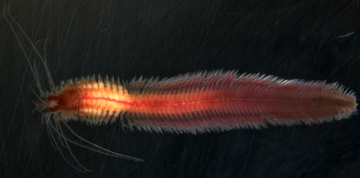720724_Light Proteins_360 px width.png

Bristle worms have light reactive proteins that modify their bodies for mating between the new and full moon. Credit: Martin Gühmann, CC BY-SA 4.0
For a tiny marine worm found in the Bay of Naples and elsewhere, life ends in a frenzy. The worms lose a lot of their internal organs, their eyes get bigger, and they rise to the surface. There, as they paddle furiously, they release sperm and eggs, creating the next generation. And it’s all triggered by moonlight.
The worms are one of more than 10,000 species of marine bristle worm. They’re only about an inch long. Each body segment has a pair of paddle-like structures tipped with bristles. The worms live at the bottom of warm, shallow waters around the world. And they’re considered “living fossils”—they haven’t changed much in tens of millions of years.
The bristle worms are especially sensitive to changing light levels. They build tubes on the ocean floor. When a shadow passes across them, they pull back into the tubes to elude possible predators. And their end-of-life ballet is triggered by moonlight.
The body changes begin around the time of “new” Moon, when there’s little or no moonlight. The worms then rise to the surface not long after the full Moon.
Scientists recently studied how that happens. They found that some proteins react differently with different light levels. Under bright sunlight, they stay apart, in separate units. But under dimmer conditions, the units stick together. That allows the worms to not only distinguish between day and night, but between different phases of the Moon—a light-activated “trigger” for a big change.

